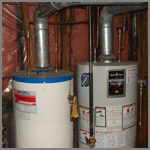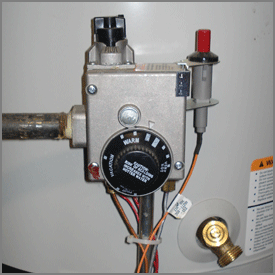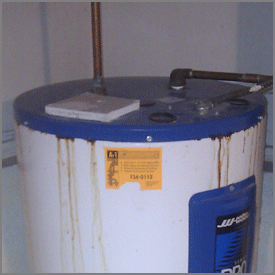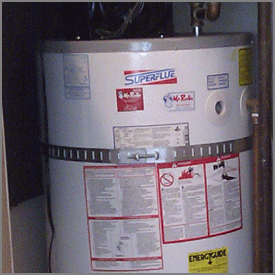
What do you need to know about your hot water tank (HWT)? These deceptively simple appliances can complicate your life infinitely maybe even end it. They usually operate so flawlessly we take them for granted.
HWT Dating
Dating a hot water tank is important because water tanks last on average twelve years. The last three tanks I replaced lasted 5, 8, and 22 years. By knowing a tanks age you have a better idea when it might fail.
If your hot water tank has a Bar-B-Q style electronic igniter on the heat controler it is 2005 or newer. If you require a match or lighter to ignite the pilot light it is older than 2005. There are ways of decoding your serial number to identify its exact age but I suggest simply calling the manufacturer with the serial number. They will tell you how old your tank is.

The red button with the organge wire is
the electronic igniter (2005 or Newer)
HWT fail
It might surprise you to know that many tanks fail at the top first. The tell tail signs are dripping rust stains below the seam where the top cap meets the body of the tank. You may also notice rusting or stains on the top of the tank near penetrations. Any time there are signs that a tank is failing it is time to replace it. If you are not sure call in a reputable plumber before a more catastrophic failure occurs.

Leaking usually starts at the top
HWT can kill you
Combustions style hot water tanks burn natural gas or propane to heat the water in the tank. Anytime fuel is burned it produces carbon monoxide among other emissions. Carbon monoxide is also known by another name, the silent killer. To prevent carbon monoxide poisoning hot water tanks are vented outside the home. When something goes wrong with this venting system carbon monoxide may endanger your family.
A simple solution to this issue is to install a carbon monoxide alarm. These devices operate like a smoke alarm. They are inexpensive and plug into a wall outlet. Combination alarms are also available that sense both natural gas and carbon monoxide.
HWT can burn you
Temperature settings
Temperature settings on hot water tanks are important. If your hot water tank is set too high the water at your fixtures can burn you. CSA suggest a water temperature of 120ºF maximum at the faucet. At this temperature it would take an adult approximately 5 minutes of exposure for a third-degree burn. At 150ºF this time is reduced to 1-2 seconds, 140ºF for 6 seconds, and at 130ºF for thirty seconds.
It is also important to note children are more susceptible to burns than adults. By reducing the temperature of your hot water tank you are also saving money on your heating bill.
Pressure relief valve
Many people have probably wondered what’s that pipe pointing towards the floor on the side of my water tank for. It’s a discharge tube and they’re there for your safety. At the top of that pipe near the top of your water tank is a pressure relief valve also called a temperature relief valve or TRP valve. Its job is to open if the water in your tank gets too hot 210ºF or if there is too much pressure 150psi. This is to mitigate the danger of an explosion.
When this valve opens to discharges its 210ºF water you want it to be close to the floor (6 to 12 inches) to minimize the chances of spraying scalding water on someone.
Combustible clearances
All hot water tanks and their vents heat up and most have a requirement to be clear of combustibles. This is important both during the installation of the tank but also for storage around the tank after. Piling a bunch of wrapping paper, mops or winter cloths around or on top of your water tank is never a good idea, and most likely a fire hazard.
HWT are heavy
On the west coast we live in an earthquake zone. Water tanks are heavy and considerable damage can occur it they fall over. Seismic straps are used to support the top of the tank to keep it stable.
Your reaction might be if my water tank topples in an earthquake what do I care. Now imagine you are trapped in your home when the tank falls. Busted pipes could be filling your home with natural gas or water and your electrical might be sparking.

Siesmic straps must be attached to solid
structure to be effective
HWT mitigating water damage
Water shut-offs
When you move into a new home make sure you know the location of your water shut-off valves. Typically you have two main valves. The most important valve is located on the water main entering your home. This will turn off the hot and cold water to your entire home in an emergency.
The second most important valve is located on the cold water line supplying your hot water tank. This is typically found just above the tank and will shut off all the hot water in your home.
Catch basin with a drain
A catch basin is an oversized pan that your hot water tank sits in to capture any small leaks that may occur. When it is connected to a drain it greatly diminishes the risk of water damage from a leaking tank because even if you notice a leak and turn off the water there is typically still over forty gallons of water waiting to escape.
Water sensor
For added security some people are adding alarms under their water tanks these days. These can be simple plug in alarms that you will hear if they go off when your home or they can be tied into security systems to notify system monitors if there is a leak.
